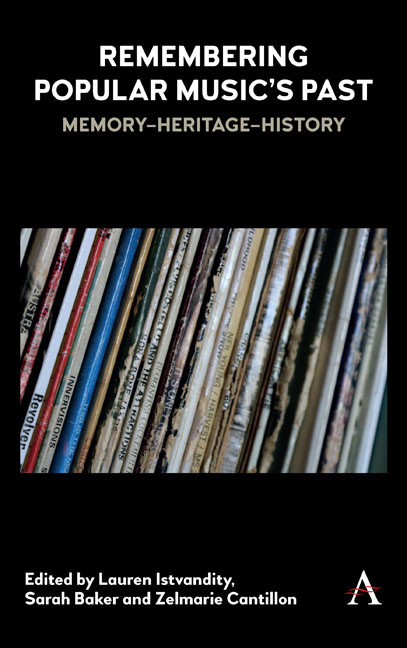Book contents
- Frontmatter
- Contents
- List of Figures
- Acknowledgements
- Chapter 1 The Precarity of Memory, Heritage and History in Remembering Popular Music's Past
- Part I MEMORY
- Chapter 2 Consuming Popular Music Heritage
- Chapter 3 ‘Back in the Day’: Experiencing and Retelling the Past as a Claim to Belong in the Current Northern Soul Scene
- Chapter 4 Resilience and Change: Popular Folk Songs in a Cultural Landscape
- Chapter 5 Remembering the Independent Record Shop: The Ordinary Affects of Leedin Records
- Chapter 6 Mean Streets as Heritage Object: Music, Nostalgia and the Museumification of Martin Scorsese
- Part II HERITAGE
- Part III HISTORY
- List of Contributors
- Index
Chapter 3 - ‘Back in the Day’: Experiencing and Retelling the Past as a Claim to Belong in the Current Northern Soul Scene
from Part I - MEMORY
Published online by Cambridge University Press: 09 July 2019
- Frontmatter
- Contents
- List of Figures
- Acknowledgements
- Chapter 1 The Precarity of Memory, Heritage and History in Remembering Popular Music's Past
- Part I MEMORY
- Chapter 2 Consuming Popular Music Heritage
- Chapter 3 ‘Back in the Day’: Experiencing and Retelling the Past as a Claim to Belong in the Current Northern Soul Scene
- Chapter 4 Resilience and Change: Popular Folk Songs in a Cultural Landscape
- Chapter 5 Remembering the Independent Record Shop: The Ordinary Affects of Leedin Records
- Chapter 6 Mean Streets as Heritage Object: Music, Nostalgia and the Museumification of Martin Scorsese
- Part II HERITAGE
- Part III HISTORY
- List of Contributors
- Index
Summary
The term ‘northern soul’ refers to both a canon of primarily 1960s American records and a music-focused community that developed in the United Kingdom in the 1970s and continues to attract a multigenerational and international following. Participation is orchestrated by a scene calendar of ‘soul nites’ (that run 9 p.m.–midnight), ‘alldayers’ (midday into the evening) and ‘allnighters’ (from 9 p.m. to 8 a.m.). These events are organized by individuals active on the scene, and most are run in an attempt to cover costs, rather than to make a profit. Scene practices revolve around dancing to, DJing and collecting within this canon of supposedly rare records from a range of genres –from American R&B to funk –that have become associated with the scene (see Wall 2006). The construction and sharing of the history of the scene is a do-it-yourself process undertaken by scene insiders, and more specifically by individuals who claim the right to speak on behalf of the scene through their personal experience of northern soul in the 1970s (see Raine and Wall 2017; Raine and Wall 2019). As such, the diverse experiences and wide network of dance halls and youth clubs of the past have been streamlined into a linear, dominant narrative: an ‘official’ history of particular mythologized venues and their associated vinyl. Furthermore, this official history is preserved through the very processes of claiming membership, with the past conveying value on those who are able to demonstrate a personal experience of this past.
This chapter draws on a three-year ethnographic study of the British northern soul scene. It explores how the northern soul past is lived in the present and illuminates the precarity of these interlinked processes of heritagization and membership for the scene's younger participants who are part of a music community that values original participation in the 1970s. Referencing interviews and my own experience, I consider how personal and shared engagements with the past and with the passing of time are encoded into scene practices. In doing so, I show how a collective understanding of this past is organized through stories of northern soul nights, told and retold by an older generation of scene participants in their claim to authentic participation.
- Type
- Chapter
- Information
- Remembering Popular Music's PastMemory-Heritage-History, pp. 27 - 40Publisher: Anthem PressPrint publication year: 2019

